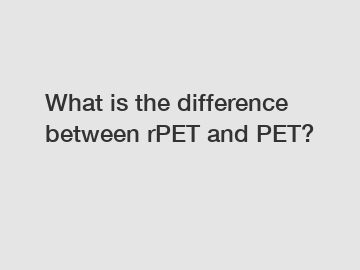Feb. 09, 2024
Environment
What is the difference between rPET and PET?
rPET and PET are two types of plastic materials that are commonly used in various industries. While they may sound similar, there are some significant differences between the two materials.
rPET, short for recycled polyethylene terephthalate, is a type of plastic that is made from recycled PET materials. PET, on the other hand, stands for polyethylene terephthalate and is a type of plastic that is produced from petroleum-based materials. The main difference between rPET and PET lies in their manufacturing process and environmental impact.

The process of producing rPET starts with the collection of used PET products such as plastic bottles. These bottles are then sorted and cleaned to remove any impurities. After cleaning, the PET is shredded into small flakes and then melted down to be formed into new plastic products. This recycling process reduces the need for new raw materials and helps to reduce waste and environmental pollution.
In contrast, the production of PET involves extracting petroleum and other fossil fuels, which have a negative impact on the environment. The extraction and refining of petroleum release greenhouse gases and pollutants, contributing to climate change and air pollution. Additionally, the production of PET requires a significant amount of energy and water, further depleting natural resources.
The use of rPET instead of PET has several significant benefits. Firstly, it reduces the demand for petroleum-based materials, thus decreasing our reliance on fossil fuels. This, in turn, helps to mitigate the environmental damages associated with petroleum extraction and refining. Secondly, the recycling process of rPET reduces waste and promotes a more circular economy, where resources are conserved and reused rather than disposed of.
Moreover, using rPET significantly reduces the carbon footprint of plastic production. The production of rPET requires significantly less energy and releases fewer greenhouse gas emissions compared to the production of PET. This makes rPET a more sustainable and eco-friendly choice for various industries, including packaging, textiles, and consumer goods.
In conclusion, rPET and PET are two types of plastics with key differences in their manufacturing process and environmental impact. rPET is produced from recycled PET materials, reducing the need for new raw materials and minimizing waste. In contrast, PET is made from petroleum-based materials, contributing to environmental pollution and resource depletion. The adoption of rPET offers numerous benefits, including reducing reliance on fossil fuels, promoting a circular economy, and decreasing carbon emissions. As consumers and businesses increasingly prioritize sustainability, the use of rPET is becoming more prevalent, contributing to a greener and more environmentally conscious future.
Contact us to discuss your requirements of rPET pellets, rPET pellets, rPET pellets. Our experienced sales team can help you identify the options that best suit your needs.
If you are interested in sending in a Guest Blogger Submission,welcome to write for us!
All Comments ( 0 )